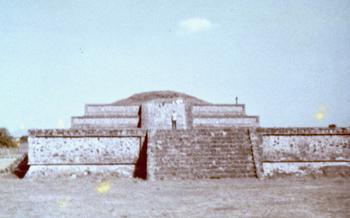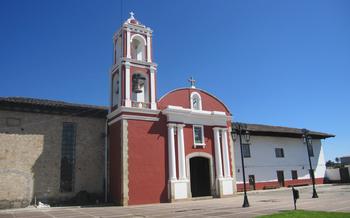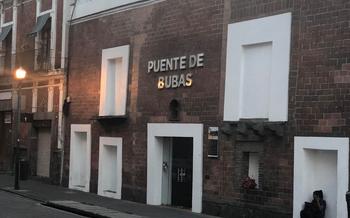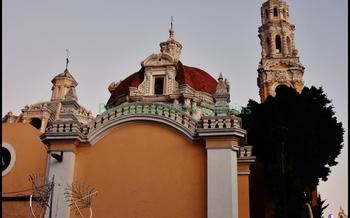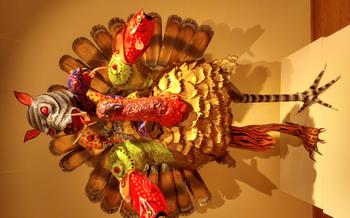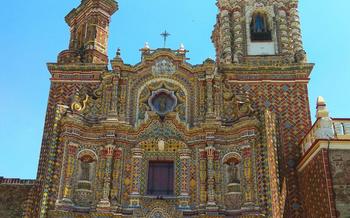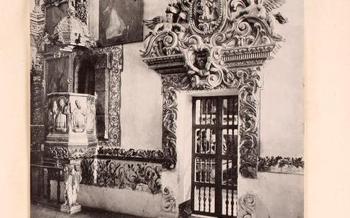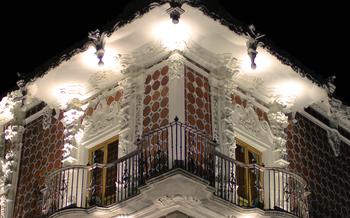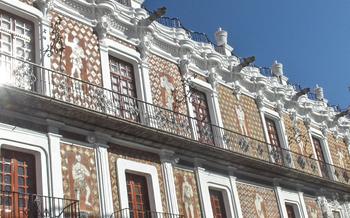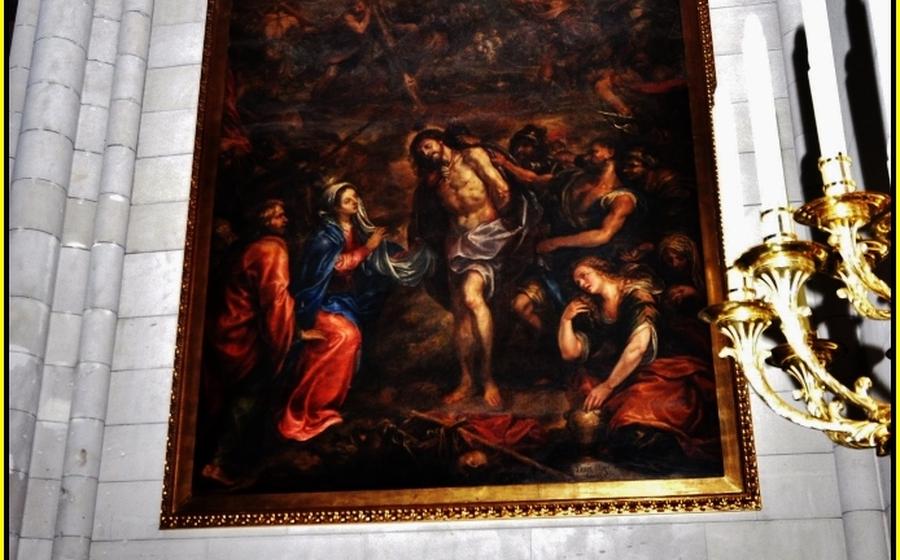
Plaza de la Victoria
- Plaza de la Victoria: A Historical Gem in Puebla
- Puebla Cathedral: A Baroque Masterpiece
- Casa del Alfeñique: A Unique Talavera Masterpiece
- Callejón de los Sapos: A Hidden Gem
- El Parián Market: A Shopping Paradise
- Gastronomic Delights: Puebla's Cuisine
- Visit the Nearby Archaeological Sites
- Attend Festivals and Events
- Explore the Surrounding Villages
- Enjoy Outdoor Activities
- Insider Tip: Discover Hidden Gems
Plaza de la Victoria: A Historical Gem in Puebla
History and significance of the plaza: In the heart of Puebla, history unfolds at the Plaza de la Victoria, a vibrant square that has witnessed centuries of change. Founded in 1531, the plaza played a pivotal role in the city's development, serving as a gathering place for trade, celebrations, and political events. Its name, meaning "Victory Square," commemorates the triumph of the Spanish over the indigenous Tlaxcalan forces, a victory that marked a turning point in the conquest of Mexico.
Architectural highlights: The plaza is a showcase of architectural excellence, blending colonial and modern styles. The majestic Puebla Cathedral, with its soaring spires and intricate Baroque facade, dominates one side of the square. Opposite the cathedral, the Palacio Municipal, with its elegant arches and vibrant murals, exudes a sense of civic pride. The surrounding buildings, with their colorful facades and intricate wrought-iron balconies, create a harmonious ensemble that transports visitors back in time.
Cultural importance: The Plaza de la Victoria is not just a physical space but also a cultural hub. It hosts numerous festivals, concerts, and cultural events throughout the year, celebrating Puebla's rich heritage and vibrant traditions. During the Day of the Dead, the plaza transforms into a sea of colorful altars, as families gather to honor their departed loved ones. The annual Feria de Puebla, held in April, fills the air with music, dance, and merriment, attracting visitors from far and wide.
Puebla Cathedral: A Baroque Masterpiece
The Puebla Cathedral, also known as the Cathedral of Our Lady of the Immaculate Conception, stands proudly in the heart of the city's Zócalo, a testament to the architectural prowess of the Baroque era. Its construction began in 1575 and spanned over two centuries, resulting in a harmonious blend of architectural styles, from Gothic to Baroque. The cathedral's facade boasts an impressive array of intricate carvings, sculptures, and reliefs depicting scenes from the Bible and the lives of saints.
Inside, the cathedral's opulence continues with its soaring vaulted ceilings, ornate altars, and exquisite artwork. The main altarpiece, a masterpiece of Churrigueresque style, is adorned with gold leaf, cherubs, and intricate carvings that tell the story of the Immaculate Conception. The cathedral also houses a collection of valuable paintings, sculptures, and religious artifacts, making it a true treasure trove of artistic and cultural significance.
Beyond its architectural and artistic merits, the Puebla Cathedral holds immense religious importance for the city's residents and visitors alike. It is the seat of the Roman Catholic Archdiocese of Puebla and a popular pilgrimage site, attracting thousands of faithful throughout the year. Whether you're a history buff, an art enthusiast, or a spiritual seeker, the Puebla Cathedral offers an awe-inspiring experience that will leave you captivated.
Casa del Alfeñique: A Unique Talavera Masterpiece
Amid the vibrant streets of Puebla, nestled between colonial buildings and bustling markets, stands the Casa del Alfeñique, a testament to the city's rich architectural heritage. This stunning mansion, built in the 18th century, is a prime example of the intricate Talavera tilework that has become synonymous with Puebla.
The facade of the Casa del Alfeñique is a visual masterpiece, adorned with vibrant tiles depicting religious scenes, mythical creatures, and intricate floral motifs. The vibrant colors and intricate designs seem to dance in the sunlight, creating a captivating spectacle that draws the eyes of passersby.
Step inside the Casa del Alfeñique, and you'll be transported to a world of opulence and grandeur. The interior walls are lined with even more exquisite Talavera tiles, each one telling a story or representing a different aspect of Mexican culture.
Today, the Casa del Alfeñique serves as a museum, showcasing the history and significance of Talavera tiles. Visitors can wander through the rooms, admiring the intricate tilework, learning about the techniques involved in their creation, and gaining an appreciation for the artistry and craftsmanship that went into this unique form of Mexican expression.
Callejón de los Sapos: A Hidden Gem
Nestled in the heart of Puebla's historic center, Callejón de los Sapos (Alley of the Toads) is a narrow, cobblestone street that exudes charm and mystery. Its name, derived from the ceramic tiles depicting toads that adorn its facades, hints at the alley's rich history and folklore.
Legends abound regarding the alley's origins. One tale suggests that it was once a sacred path for indigenous rituals, while another claims that it was a meeting place for witches and sorcerers. The eerie atmosphere, accentuated by the towering buildings and dimly lit corners, adds to the alley's allure.
The architectural style of Callejón de los Sapos is a blend of colonial and contemporary influences. Colorful facades, wrought-iron balconies, and intricate carvings create a visually captivating streetscape. Quirky shops and galleries line the alley, offering a unique blend of traditional crafts, contemporary art, and souvenirs.
Callejón de los Sapos is a hidden gem that invites visitors to explore its secrets and immerse themselves in the captivating atmosphere of Puebla's historic center. Whether you're a history buff, an art enthusiast, or simply seeking a unique experience, this charming alley promises an unforgettable encounter.
El Parián Market: A Shopping Paradise
El Parián Market, located in the heart of Puebla's historic center, is a vibrant and colorful shopping hub that has been a part of the city's commercial landscape for centuries. Originally built in the 16th century as a marketplace for indigenous traders, it has evolved into a bustling bazaar offering a diverse array of traditional crafts, souvenirs, and local delicacies.
As you step into the market, the air fills with a heady mix of aromas, from the sweet scent of vanilla to the earthy fragrance of leather. Stalls line the narrow alleys, showcasing an impressive variety of goods, including hand-embroidered textiles, intricately carved wooden crafts, and gleaming Talavera pottery.
Bargaining is an essential part of the El Parián experience, and visitors can engage in friendly negotiations with the friendly vendors to secure the best prices. The market is also a great place to sample regional specialties, such as the famous mole poblano, a rich and complex sauce served with chicken or turkey.
In addition to its commercial offerings, El Parián Market holds cultural significance as a meeting place for locals and tourists alike. It serves as a vibrant backdrop for various cultural events, including traditional dance performances and live music concerts.
Gastronomic Delights: Puebla's Cuisine
Puebla's cuisine is a symphony of flavors and textures, a culinary journey that tantalizes the taste buds and leaves a lasting impression. The city's rich history and cultural diversity have given rise to a unique gastronomic heritage that is celebrated far and wide.
Among the must-try specialties is mole poblano, a complex and flavorful sauce made with dozens of ingredients, including chocolate, spices, and nuts. This culinary masterpiece is often paired with tender chicken or pork and served over rice.
Chalupas are another local delicacy, consisting of crispy fried tortillas topped with shredded beef, salsa, and fresh cheese. These savory treats are a popular street food and can be found in markets and restaurants throughout the city.
Cemitas are hearty sandwiches made with sesame-seed buns, filled with a variety of meats, cheeses, and vegetables. These local favorites are a must-try for those seeking a quick and delicious meal.
To fully immerse yourself in Puebla's culinary delights, consider taking a gastronomic tour or enrolling in a cooking class. These experiences offer hands-on opportunities to learn about traditional recipes, cooking techniques, and the history behind Puebla's renowned cuisine.
Visit the Nearby Archaeological Sites
Puebla's proximity to several significant archaeological sites makes it an ideal base for history and culture enthusiasts. Just a short drive away, visitors can explore the ancient city of Cholula, home to the Great Pyramid of Cholula, the largest pyramid in the world by volume. This impressive structure, also known as Tlachihualtepetl, offers a glimpse into the rich history of the region and provides stunning panoramic views from its summit.
Another must-visit site is Cantona, located about an hour's drive from Puebla. This ancient city boasts impressive ruins, including a large main pyramid, several smaller temples, and a ball court. The site's strategic location on a hilltop affords breathtaking views of the surrounding valley, making it a popular spot for photography enthusiasts.
These archaeological sites offer a unique opportunity to delve into the fascinating history and culture of Mexico's pre-Hispanic past. Visitors can admire the architectural prowess of the ancient civilizations, learn about their beliefs and customs, and gain a deeper appreciation for the region's rich cultural heritage.
Attend Festivals and Events
Puebla is renowned for its vibrant festivals and events that showcase its rich cultural heritage and traditions. Immerse yourself in the lively atmosphere of Cinco de Mayo, a national holiday commemorating the Mexican army's victory over the French in 186The city erupts in a kaleidoscope of colors, music, and dance, with parades, traditional costumes, and lively street parties.
Experience the awe-inspiring Day of the Dead (Día de los Muertos), a UNESCO-recognized cultural heritage event. The city transforms into a realm of marigolds, altars, and colorful decorations honoring the deceased. Witness the poignant candlelit processions, visit the vibrant cemeteries adorned with offerings, and savor the unique culinary creations associated with this special occasion.
Explore the Surrounding Villages
Beyond the city limits of Puebla, a wealth of charming villages awaits exploration, each offering unique experiences and cultural insights.
-
Cholula: A short drive from Puebla, Cholula boasts a captivating blend of colonial architecture and ancient history. Wander through its cobblestone streets, marvel at the towering Great Pyramid, and visit the colorful churches and convents that dot the landscape.
-
Atlixco: Known for its vibrant flower markets and colorful facades, Atlixco is a feast for the senses. Stroll through the lively zócalo, admire the intricate murals adorning the buildings, and indulge in delicious local specialties like cecina and cemitas.
-
Tlaxcala: Steeped in ancient history and indigenous traditions, Tlaxcala is a must-visit for history enthusiasts. Explore the impressive ruins of the ancient city of Cacaxtla, learn about the rich indigenous heritage at the Museo Nacional del Títere, and savor the flavors of traditional Tlaxcalan cuisine.
Enjoy Outdoor Activities
Beyond the historical and cultural attractions, Puebla offers a range of outdoor activities for nature enthusiasts and adventure seekers. The city is surrounded by picturesque mountains, inviting visitors to embark on hiking or biking trails amidst stunning scenery. Embrace the challenge of ascending the slopes and be rewarded with breathtaking panoramic views.
For a unique wildlife experience, venture to Africam Safari Park, located just a short drive from Puebla. This expansive wildlife sanctuary is home to over 5,000 animals from various continents, providing an opportunity to observe exotic species in their natural habitat. Get up close with majestic lions, playful zebras, towering giraffes, and a variety of other fascinating creatures.
Take advantage of Puebla's clear skies and embark on a hot air balloon ride. Soar above the city and witness the unfolding tapestry of colorful buildings, historical landmarks, and the surrounding countryside from a bird's-eye perspective. This unforgettable experience offers a unique vantage point to appreciate the beauty of Puebla from a new angle.
Insider Tip: Discover Hidden Gems
Beyond the main attractions, Puebla offers a treasure trove of hidden gems waiting to be discovered. Explore the fascinating underground tunnels that once served as a water supply system, providing a glimpse into the city's engineering prowess. Immerse yourself in the history of transportation at the Museo del Ferrocarril Mexicano, showcasing a collection of vintage locomotives and carriages. Embark on a guided tour to gain a deeper understanding of Puebla's rich history, culture, and traditions, unlocking the secrets of this vibrant city.
